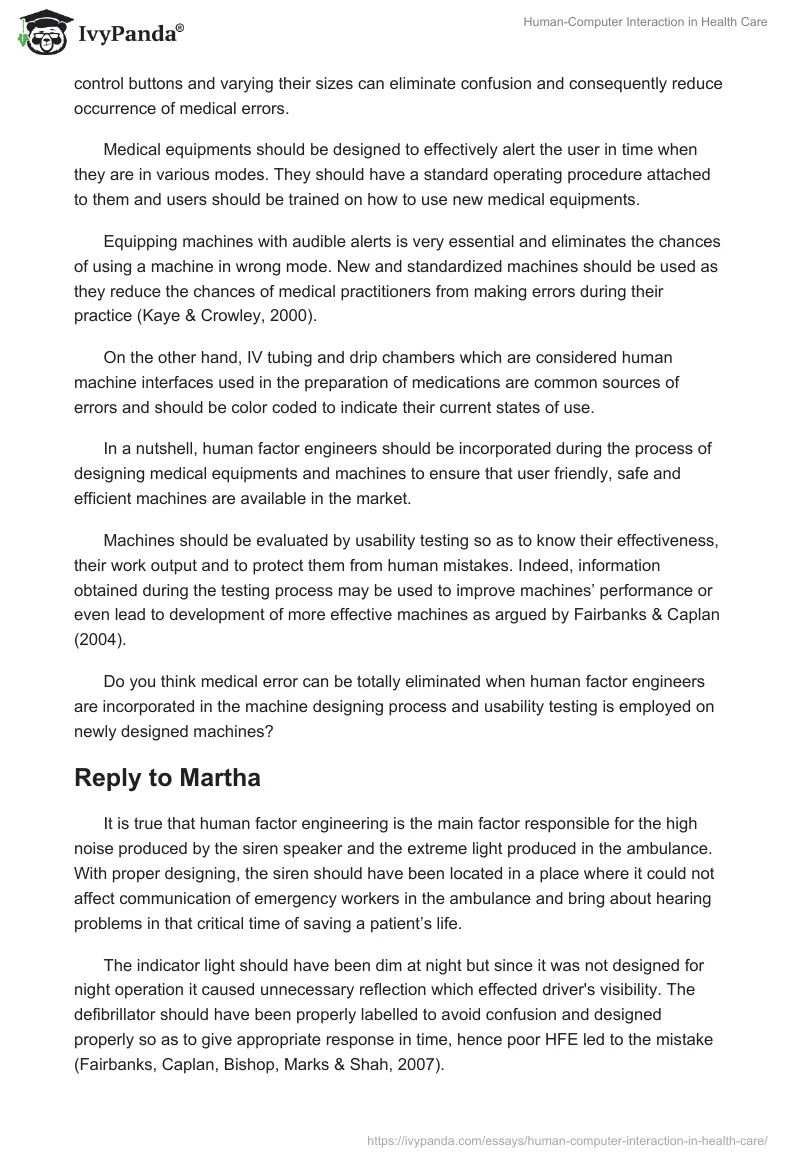Medical errors are increasing in hospitals and normally considered as a result of human fault. Poor interface design which is because of poor human factor engineering (HFE) is the main factor which causes medical errors. Lack of usability testing of medical instruments is another factor which results in medical mistakes.
Poor human factor engineering arises problems, such as poorly designed indicator lights inside ambulances and siren speakers on ambulances. Most indicator lights in ambulances are not properly designed to maintain a proper operation process during the day and night and may cause unnecessary considerations affecting driver’s visibility.
On the other hand, siren speakers may produce a lot of noise which will interfere emergency workers inside the ambulance to perform their work, and this may cause errors (Carl, Aaron & Elefterios, 2011)
Poor HFE leads to designing of machines which do not alert the user in time when they are in various modes. In addition, similar button, which controls systems on medical instruments, may confuse users, and this may result in medical errors.
Gadgets like infusion pumps used in hospitals to automate drip rates are prone to make mistake. Drip chambers and IV tubing for preparation of medication may be reused leading to overdose of patients. On the other hand, lack of usability testing may cause difficulties during operation of various machines causing errors (Fairbanks & Caplan, 2004).
The following interventions may be employed to reduce medical errors. First, indicator lights in ambulances should be properly designed for various environments. Secondly, sound produced by siren speakers on ambulance should not interfere with communication of emergency works.
Similar control buttons should be placed on machines to avoid confusion. Control buttons should be grouped in terms of usage frequency and relatedness. Labelling control buttons and varying their sizes can eliminate confusion and consequently reduce occurrence of medical errors.
Medical equipments should be designed to effectively alert the user in time when they are in various modes. They should have a standard operating procedure attached to them and users should be trained on how to use new medical equipments.
Equipping machines with audible alerts is very essential and eliminates the chances of using a machine in wrong mode. New and standardized machines should be used as they reduce the chances of medical practitioners from making errors during their practice (Kaye & Crowley, 2000).
On the other hand, IV tubing and drip chambers which are considered human machine interfaces used in the preparation of medications are common sources of errors and should be color coded to indicate their current states of use.
In a nutshell, human factor engineers should be incorporated during the process of designing medical equipments and machines to ensure that user friendly, safe and efficient machines are available in the market.
Machines should be evaluated by usability testing so as to know their effectiveness, their work output and to protect them from human mistakes. Indeed, information obtained during the testing process may be used to improve machines’ performance or even lead to development of more effective machines as argued by Fairbanks & Caplan (2004).
Do you think medical error can be totally eliminated when human factor engineers are incorporated in the machine designing process and usability testing is employed on newly designed machines?
Reply to Martha
It is true that human factor engineering is the main factor responsible for the high noise produced by the siren speaker and the extreme light produced in the ambulance. With proper designing, the siren should have been located in a place where it could not affect communication of emergency workers in the ambulance and bring about hearing problems in that critical time of saving a patient’s life.
The indicator light should have been dim at night but since it was not designed for night operation it caused unnecessary reflection which effected driver’s visibility. The defibrillator should have been properly labelled to avoid confusion and designed properly so as to give appropriate response in time, hence poor HFE led to the mistake (Fairbanks, Caplan, Bishop, Marks & Shah, 2007).
Reply to Gary
According to Gary, poor human factor engineering and human factors were responsible for most of the adverse events during the medical operation. On the other hand, the indicator light should have been dim and noise exposure on the paramedics should have been minimized not to interfere with communication between the workers.
Carl, Aaron & Elefterios (2011) argue that besides causing hearing , siren noise may bother other drivers on the road which may lead to accidents worsening situations. The defibrillator was not effective enough to elicit immediate response, and this could only be attributed to poor HFE.
Joseph & Laurie (2003) argue that human factors like medical negligence may lead to errors during medical operations. It is known that paramedics ignore minor details which may result in making mistakes in rush hours while trying to save the lives of patients.
These minor mistakes made by humans are preventable when one is careful. For example, calculating volumes accurately, avoiding reuse of IV bags and remixing IV bags or other materials frequently used in drug preparation may reduce human errors.
Question for the class
Do you think medical error reporting systems are inadequate or do not exist in most hospitals?
References
Carl, Q.H., Aaron, J.M., & Elefterios, P.P. (2011). Acoustic characteristics for effective ambulance sirens school of mechanical engineering, Acoustics Australia, 39(2), 43-53. Web.
Fairbanks, R.J., & Caplan, S. (2004). Poor Interface Design and Lack of Usability Testing Facilitate Medical Error, Joint Commission Journal on Quality and Safety, 30(10), 579-584. Web.
Fairbanks, R.J., Caplan, S.H., Bishop, P.A., Marks, A.M., & Shah, M.N. (2007). Usability Study of Two Common Defibrillators Reveals Hazards. Annals of Emergency Medicine, epubahead of print. Web.
Joseph, L.H., & Laurie, S. (2003). Medical errors and Patient Safety: A curriculum guide for teaching medical students and family practice residents. Web.
Kaye, R., & Crowley, J. (2000). Medical Device Use-Safety: Incorporating Human Factors Engineering into Risk Management Identifying, Understanding, and Addressing Use-Related Hazards. Web.


